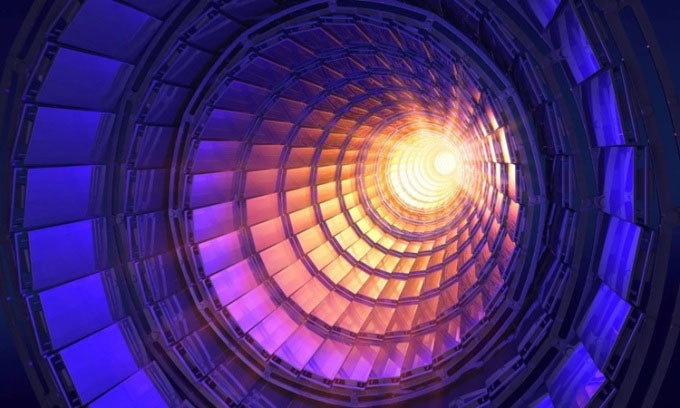China is building the world's largest particle accelerator
With the aim of creating "God particles", China is preparing to build a circular particle accelerator in a 100km underground tunnel.
The $5 billion Circular Electron Positron Collider (CEPC), also known as the Higgs factory , will take about 10 years to build and become the next global center of particle physics, according to Wang Yifang, director Institute of high energy physics in Beijing, Interesting Engineering reported on March 8. By accelerating electrons and their antiparticles, positrons, in a 100km underground tunnel to extremely high energies and crashing them into each other, CEPC will create millions of Higgs bosons, allowing scientists to create new discoveries beyond the Standard Model, today's best hypothesis to describe the basic building blocks of the universe.

Inside the particle accelerator tunnel. (Photo: iStock).
The ambitious project will also help China rise to the top of the world and pioneer in the field of high energy physics. According to Wang, CEPC's technical design report involved 1,000 scientists from 24 countries and took 5 years to complete, passed international review and responded to feedback from the physics community when announced last December.
The report, combined with many prototype devices built and tested over the past decade, demonstrates China's ability to design and build such a large scientific facility. The idea of building CEPC was first proposed by Wang and his colleagues in 2012 after the Higgs boson, also known as the "God Particle", the particle that gives mass to almost all other particles, was discovered using the Accelerator. Europe's Large HHC (LHC).
While the Higgs boson is believed to hold the key to the next breakthroughs in fundamental physics, there are many doubts about CEPC's high cost and technological readiness. Wang admitted that $5 billion is not a cheap cost. However, if CEPC can support research for thousands of scientists in the coming decades, the average cost will not be high. According to the technical design report, authorities are considering funding sources, with expected contributions from the central government, local authorities and international partners.
CEPC construction is currently in the engineering design phase, which includes mass production and assembly of accelerator components, as well as optimization of their performance and cost-effectiveness. Wang's team will also soon finalize the location for CEPC. He said there will be a comprehensive assessment based on geological conditions, traffic and infrastructure because CEPC will welcome scientists from around the world and factors such as children's education need to be considered.
Potential locations include: Qinhuangdao in Hebei province, Huzhou in Zhejiang province and Changsha in Hunan province. Meanwhile, in Europe, a similar project called the Future Circular Collider will succeed the Large Hadron Collider. As the largest particle accelerator in the world today, the LHC has a circumference of 27 km. The circumference of the future Circular Collider could reach 100 km at a cost of 23 billion USD.
- China built the world's largest particle accelerator
- China wants to build a particle accelerator twice as large as the LHC
- China will have the world's largest particle accelerator
- Can this Chinese super machine
- The LHC accelerator will operate at the highest energy before
- Discover the idea of building a particle accelerator on the Moon
- Important discovery: The first decay observation of the Higgs particle
- The world's largest particle accelerator is about to resume operation
- Visit the biggest machine in human history
- Making a tiny particle accelerator: Only half the size of a hair, fits on a chip
- Announced plans to build the world's largest machine
- The powerful particle accelerator is equivalent to 10 million lightning strikes
 Norway built the world's tallest wooden tower
Norway built the world's tallest wooden tower Kremlin
Kremlin Ashurbanipal: The oldest royal library in the world
Ashurbanipal: The oldest royal library in the world Decoding the thousand-year construction of Qin Shihuang shocked the world
Decoding the thousand-year construction of Qin Shihuang shocked the world